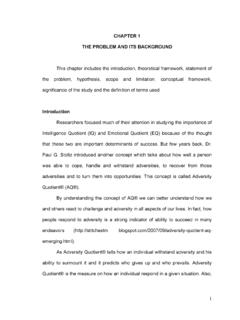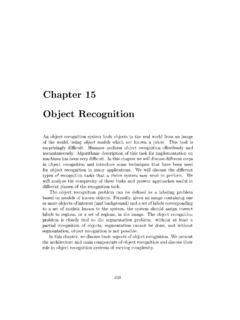Transcription of Chapter
1 C h a pter 5. Pain Jeannine M. Brant, phd, aprn, aocn . The problem pain is more than a physiologic process. Pain is psychologi- cal and can remind patients of their cancer and uncertainty Pain is a significant problem in patients with cancer and is of the future. Patients may even suppress pain in an effort often the most feared aspect of the disease. A multitude of to protect their family and deny pain due to fear of disease pain guidelines exist to guide the management of cancer progression. Socially, patients may become isolated as pain pain,2 3 and the World Health Organization (WHO) esti- keeps them from enjoying social activities and relationships. mates that its ladder for cancer pain can adequately manage Spirituality can affect individual perception and intensity pain in approximately 80% 90% of The health- about pain, the significance of the meaning of pain, and care team has a professional and ethical responsibility to the acceptance of the medical treatment plan.
2 If total pain assess and adequately manage pain in patients throughout involves the physical, psychological, social, and spiritual the cancer trajectory. Being aware of the incidence and domains, then the management of pain should likewise etiology of cancer pain is important to recognize how this encompass all 8. problem impacts every aspect of the cancer illness. Appreci- Despite the full armamentarium of strategies available, ating the global aspects of pain enables clinicians to identify cancer pain remains undertreated, and a multitude of barri- high-risk patients and obtain a comprehensive pain assess- ers exist to its management. Data suggest that while a focus ment. Recognizing that the assessment should focus on the on cancer pain has existed for more than 20 years, pain is patient's perspective of pain, however it is defined, is critical not adequately addressed, and misperceptions and limita- in pain Finally, understanding the pathophysi- tions exist in pain-related knowledge and Barriers ology of pain enables healthcare professionals to use both comprise healthcare professionals, healthcare systems, and pharmacologic and nonpharmacologic interventions that patients and families.
3 Can interrupt pain signals along the pain pathway. First, healthcare professionals have inadequate knowl- According to the International Association for the Study edge about pain assessment and management. A recent of Pain, pain is defined as a sensory and emotional experi- study indicated that the most common physician-related ence associated with actual or potential tissue damage or barriers to adequate cancer pain management were insuf- described in terms of such damage. 5 The definition rein- ficient knowledge and inadequate opioid A. forces the fact that pain is not just physical, but rather is a plethora of studies indicate that nurses' knowledge of pain holistic experience. Total pain or global pain involves the assessment and management is also lacking, and only 49%. interplay of physical, psychological, social, and spiritual fac- of nurses in a recent study achieved a passing score of 80%.
4 Tors that constructs each patient's unique pain experience. or Lack of pain assessment is another major b arrier, Total pain reinforces the inner-connectedness between the and has been considered the greatest barrier to adequate body, mind, and spirit. Healthcare professionals commonly pain ,9,10 For nurses, The Joint Commission focus on the physical pain but should be reminded that frequently cites lack of pain assessment in the hospital setting 67. 68 Part I The problem of Symptom Distress Table 5-1. Glossary of Definitions Term Definition Pain A sensory and emotional experience associated with actual or potential tissue damage or described in terms of such damage6. Whatever the experiencing person says it is existing whenever he or she says it does Somatic Pain Pain arising from skin, muscle, tendon, joints, fasciae, and bones Visceral Pain Pain arising from visceral organs such as the lungs, GI track, liver, gallbladder, kidneys, and bladder Neuropathic Pain Pain arising from the peripheral or central nervous system Types of Pain Acute Pain Pain that is self-limiting and resolves with healing of the underlying injury Chronic Pain Persistent pain with pathology that is unable to explain the extension of pain beyond the expected period of healing Persistent Pain Prolonged pain after a transient stimulus Referred Pain Spread of pain to an uninjured tissue Breakthrough Pain A transient exacerbation of pain that occurs either spontaneously.
5 Or in relation to a specific predictable or unpredictable trigger, despite relatively stable and adequately controlled background pain End of Dose Pain Pain that occurs prior to the next dose of scheduled medication Characteristics Used to Describe Pain Allodynia A painful response to a normally innocuous stimulus Dysesthesia A spontaneous or evoked unpleasant and abnormal sensation Hyperalgesia An increased response to a noxious stimulus Hyperpathia Abnormal pain and exaggerated response, especially to a repetitive stimulus Opioid-Related Terms14. Physical Dependence A state of adaptation that is manifested by a drug class specific withdrawal syndrome that can be produced by abrupt cessation, rapid dose reduction, decreasing blood level of drug and/or administration of an antagonist. Tolerance A state of adaptation in which exposure to a drug induces changes that result in a diminution of one or more of the drug's effects over time.
6 Addiction Addiction is a primary, chronic, neurobiologic disease with genetic, psychosocial, and environmental factors influencing its development and manifestations. It is characterized by behaviors that include one or more of the following: impaired control over drug use, compulsive use, continued use despite harm, and craving. Abstinence Syndrome Occurs with abrupt cessation or diminution of an opioid following chronic use as a problem . Pain cannot be managed if it is not assessed. Third, additional barriers have been noted throughout Fears about addiction may lead to inadequate prescribing, the last two to three decades for patients and families. Fears and confusion still exists about the differences between of addiction, failure to report pain, fear that pain is a sign of addiction, tolerance, and physical dependence (Table 5-1).
7 12 disease progression, perception that pain is an expected part Second, healthcare and regulatory systems fuel the of the disease, lack of knowledge about pain management problem . Providers fear scrutiny from regulatory agencies options, lack of adherence due to side effects, and desire to and may be reluctant to prescribe opioid Most be a good patient continue to ,14 16 Barriers may recently, risk evaluation and mitigation strategies (REMS) be compounded in patients who are older,17 female, of a have added another layer to prescribing opioids for patients minority race,18 and have less education and lower socio- in economic ,19. Chapter 5 Pain 69. Incidence Table 5-2. Cancer-Related Pain Syndromes A recent systematic review of more than 52 studies indicates that pain occurs in approximately 53% of patients with Etiology Examples of Related Syndromes cancer, but the experience is highly variable and dependent upon the stage of disease, goals of treatment, and type of Direct Tumor Somatic pain Involvement Bone pain primary or metastases Pain is more common in the advanced stages of the disease, with 59% to 64% of patients with metastatic or Visceral pain terminal disease reporting pain.
8 Higher rates, up to 70%, Ascites Lymphedema were reported in earlier studies where pain was rated by a Obstruction family member and not by the patients themselves. Families Organ related pain pancreas, have been recognized to overestimate the amount of pain liver, abdominal viscera the patient is experiencing. For patients undergoing cancer Neuropathic treatment, 59% experience pain, and pain is also found to Brachial or lumbosacral plexopathies occur in 33% of patients' post curative treatment, so that Headache it is a growing concern for disease-free cancer survivors. In regard to type of cancer, 70% of patients with head and Therapeutic and Therapeutic procedure-related neck cancer experienced the most pain, followed by 60% Diagnostic Procedures Pleurodesis Post surgical pain of those with gynecologic malignancies, 59% with gas- trointestinal cancer (colon, esophageal, pancreatic), 55% Diagnostic procedure-related with lung cancer, 54% with breast cancer, and 52% with Bone marrow aspirations Lumbar puncture urogenital cancer (prostate, bladder).
9 In those patients who had pain, more than one-third assessed the pain as moder- Cancer Treatment Surgical ate to severe; as many as 43% rated their pain as moderate, Post surgical pain Pain following access device and 26% rated their pain as placement A lack of consensus in the literature exists regarding which demographic characteristics predict the most pain. Chemotherapy Arthralgias from flare reactions For example, the evidence on the prevalence of pain in Avascular necrosis from older adults is conflicting. While some studies report an corticosteroid administration increased prevalence of pain in older adults,19,21 others find Hemorrhagic cystitis no Research studies on gender differences in Mucositis cancer-related pain have also yielded inconsistent Peripheral neuropathy Hormone therapy Arthralgias Etiology Gynecomastia Biotherapy/Targeted Therapy Cancer-related pain often results from three separate Acneiform rash etiologies: from direct tumor involvement, diagnostic Bone pain related to growth factor or therapeutic procedures, or cancer treatment.
10 Cancer administration treatment-related pain can result from surgery, chemotherapy, Radiation therapy biotherapy and targeted therapy, hormone therapy, and Dermatitis radiation therapy (Table 5-2). Patients may also experi- Enteritis ence pain that is unrelated to the cancer. Examples include Mucositis arthritic pain, fibromyalgia, and chronic low back pain. Plexopathies Pain related to any of the four causes can be somatic ( , bone pain), visceral ( , pancreas, liver), or neuro- pathic. Neuropathic pain can be peripheral or centrally assessment is critical to determine the etiology of the pain mediated, and is usually caused by direct tumor inva- and to identify whether patients are experiencing more sion (approximately 64% of patients) or cancer treatment than one type of pain information that can help guide (approximately 20%).

















